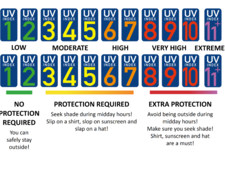-
Topics
Subnavigation
Topics
Electromagnetic fields
- What are electromagnetic fields?
- High-frequency fields
- Radiation protection in mobile communication
- Static and low-frequency fields
- Radiation protection relating to the expansion of the national grid
- Radiation protection in electromobility
- The Competence Centre for Electromagnetic Fields
Optical radiation
- What is optical radiation?
- UV radiation
- Visible light
- Infrared radiation
- Application in medicine and wellness
- Application in daily life and technology
Ionising radiation
- What is ionising radiation?
- Radioactivity in the environment
- Applications in medicine
- Applications in daily life and in technology
- Radioactive radiation sources in Germany
- Register high-level radioactive radiation sources
- Type approval procedure
- Items claiming to provide beneficial effects of radiation
- Cabin luggage security checks
- Radioactive materials in watches
- Ionisation smoke detectors (ISM)
- Radiation effects
- What are the effects of radiation?
- Effects of selected radioactive materials
- Consequences of a radiation accident
- Cancer and leukaemia
- Hereditary radiation damage
- Individual radiosensitivity
- Epidemiology of radiation-induced diseases
- Ionising radiation: positive effects?
- Radiation protection
- Nuclear accident management
- Service offers
-
The BfS
Subnavigation
The BfS
- Working at the BfS
- About us
- Science and research
- Laws and regulations
- Radiation Protection Act
- Ordinance on Protection against the Harmful Effects of Ionising Radiation
- Ordinance on Protection against the Harmful Effects of Non-ionising Radiation in Human Applications (NiSV)
- Frequently applied legal provisions
- Dose coefficients to calculate radiation exposure
- Links
What is UV radiation?
- Ultraviolet (UV) radiation covers the wavelength range of 100 nanometres (nm) to 400 nm.
- UV radiation is not visible to the human eye and cannot be perceived by the other senses either.
- UV radiation causes acute and long-term effects on the human skin and eyes and is an important environmental parameter.
 Einteilung der UV-Strahlen nach Wellenlängenbereichen
Einteilung der UV-Strahlen nach Wellenlängenbereichen
Ultraviolet (UV) radiation covers the wavelength range of 100 nanometres (nm) to 400 nm. It is the most powerful type of optical radiation. UV radiation is not visible to the human eye and cannot be perceived by the other senses either. UV radiation is divided into the following wavelength ranges:
- UV-A (400-315 nm wavelength)
- UV-B (315-280 nm wavelength)
- UV-C (280-100 nm wavelength).
UV-A radiation is adjacent to the visible light spectrum. UV-C radiation is directly adjacent to the range of ionising radiation. The shorter the wavelength, the more energetic the radiation and the more damaging the effect.
Solar UV radiation
The so-called "natural", or "solar" UV radiation is ultraviolet (UV) radiation from the sun. Solar UV radiation can penetrate the earth’s atmosphere, depending on the wavelength.
- UV-C: This highly energetic type of UV radiation is completely absorbed by the earth's high atmosphere. Solar UV-C radiation, therefore, will not reach the earth’s surface.
- UV-B: Depending on the state of the ozone layer, energetic UV-B radiation is also filtered out by the atmosphere, although not completely absorbed: Up to about ten per cent of the energetic UV-B radiation still reach the earth’s surface. Damage to the ozone layer increases the amount of UV-B reaching the earth's surface.
- UV-A: In contrast to UB-B and UV-C rays, the longer-waved UV-A radiation reaches the earth largely unobstructed.

![]() The intensity of natural UV radiation reaching the earth’s surface depends on a number of factors
The intensity of natural UV radiation reaching the earth’s surface depends on a number of factors
The intensity of UV radiation reaching the earth's surface depends on the latitude, the season and the time of day. The closer you get to the equator, the stronger the UV radiation. It is stronger in summer than winter - and at noon it is stronger than in the morning or in the evening. Cloudiness also has an effect on the intensity of UV radiation. Heavy cloud cover absorbs up to 90 % of UV radiation. However, light cloud cover – where you can still see the sun – as well as fog can intensify the UV radiation.
The elevation of the place also plays an important role: UV radiation increases by about 10 % per 1000 m difference in altitude.
Water, sand and snow reflect UV radiation, thus strengthening it. Shadow reduces UV radiation, by about 10 to 30 % under a sunshade, for example, and by about 20 % under a tree with a dense and large-area crown.
Effects and protection
UV radiation is carcinogenic, causes immediate and long-term effects on skin and eyes and is an important environmental parameter. For this reason, the intensity of UV radiation is constantly monitored worldwide and published as the UV Index.
The UV exposure of each individual and the associated health risks depend to a large extent on their own behavior. Each of us can protect ourselves from UV radiation by our behavior when working outdoors and especially when on holiday. The UV Index provides a guide for this.
Artificially generated UV radiation
In terms of its effects, artificially generated UV radiation does not differ from natural UV radiation. Artificially generated UV radiation is used in everyday life, in technical and medical applications and in wellness (for example in sunbeds).
State of 2024.06.21





